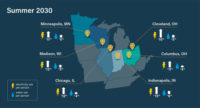At the International District Energy Association’s 2023 CampusEnergy conference in Grapevine, Texas earlier this year, campus representatives shared their stories of severe weather and how their schools are building resiliency against such events in the future.
Jennifer Meisenhelder, director of engineering and energy at University of Florida said before her university experienced two hurricanes in recent memory, “we had a 210,000 ounce per hour peak for our steam in October.
“The groundwater started about six inches below the soil because of the amount of storm. And we basically were boiling groundwater for a very long time, when we had a new peak, even though it was 80 degrees out, for steam,” Meisenhelder said, citing it as an unintended consequence of severe weather events.
Suzanne Kitten, managing director of Utilities at Texas Tech University, said her campus blocks about 70% of our natural gas volume, so compared to some of their neighbors who experienced multi-million dollar gas bills during the Texas power crisis of 2021, Texas Tech did well.
“We walked away with about $150,000 over budget for that month of February,” she said. However, the diesel fuel stockpiles Texas Tech accrued lacked a fuel preservative, or gel, necessary to make it viscous, prompting a new (if less expensive) lesson.
“Had we had to kick on additional generators, that just wouldn’t happen,” Kitten said.
Tom Nyquist, director of engineering at Princeton University, concluded a school’s local utility can’t control everything. That’s why during a regional wildfire this year, Stanford had to be shut down for three days.




